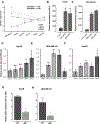Palmitate-Induced IRE1-XBP1-ZEB Signaling Represses Desmoplakin Expression and Promotes Cancer Cell Migration
- PMID: 33106375
- PMCID: PMC7864864
- DOI: 10.1158/1541-7786.MCR-19-0480
Palmitate-Induced IRE1-XBP1-ZEB Signaling Represses Desmoplakin Expression and Promotes Cancer Cell Migration
Abstract
Elevated uptake of saturated fatty acid palmitate is associated with metastatic progression of cancer cells; however, the precise signaling mechanism behind the phenomenon is unclear. The loss of cell adhesion proteins, such as desmoplakin (DSP), is a key driving event in the transformation of cancer cells to more aggressive phenotypes. Here, we investigated the mechanism by which palmitate induces the loss of DSP in liver and breast cancer cells. We propose that palmitate activates the IRE1-XBP1 branch of the endoplasmic reticulum (ER) stress pathway to upregulate the ZEB transcription factor, leading to transcriptional repression of DSP. Using liver and breast cancer cells treated with palmitate, we found loss of DSP leads to increased cell migration independent of E-cadherin. We report that the ZEB family of transcription factors function as direct transcriptional repressors of DSP. CRISPR-mediated knockdown of IRE1 confirmed that the transcription of ZEB, loss of DSP, and enhanced migration in the presence of palmitate is dependent on the IRE1-XBP1 pathway. In addition, by analyzing the somatic expression and copy number variation profiles of over 11,000 tumor samples, we corroborate our hypothesis and establish the clinical relevance of DSP loss via ZEB in human cancers. IMPLICATIONS: Provides mechanistic link on palmitate-induced activation of IRE1α to cancer cell migration.
©2020 American Association for Cancer Research.
Conflict of interest statement
Conflict of interest: The authors declare no conflicts of interest
Figures





Similar articles
-
Palmitate induces cardiomyocyte death via inositol requiring enzyme-1 (IRE1)-mediated signaling independent of X-box binding protein 1 (XBP1).Biochem Biophys Res Commun. 2020 May 21;526(1):122-127. doi: 10.1016/j.bbrc.2020.03.027. Epub 2020 Mar 19. Biochem Biophys Res Commun. 2020. PMID: 32199617
-
Transcription of the NKG2D ligand MICA is suppressed by the IRE1/XBP1 pathway of the unfolded protein response through the regulation of E2F1.FASEB J. 2019 Mar;33(3):3481-3495. doi: 10.1096/fj.201801350RR. Epub 2018 Nov 19. FASEB J. 2019. PMID: 30452881
-
Genome-wide mRNA profiling identifies X-box-binding protein 1 (XBP1) as an IRE1 and PUMA repressor.Cell Mol Life Sci. 2021 Nov;78(21-22):7061-7080. doi: 10.1007/s00018-021-03952-1. Epub 2021 Oct 12. Cell Mol Life Sci. 2021. PMID: 34636989 Free PMC article.
-
IRE1 signaling regulates chondrocyte apoptosis and death fate in the osteoarthritis.J Cell Physiol. 2022 Jan;237(1):118-127. doi: 10.1002/jcp.30537. Epub 2021 Jul 23. J Cell Physiol. 2022. PMID: 34297411 Free PMC article. Review.
-
Emerging roles for the ER stress sensor IRE1α in metabolic regulation and disease.J Biol Chem. 2019 Dec 6;294(49):18726-18741. doi: 10.1074/jbc.REV119.007036. Epub 2019 Oct 30. J Biol Chem. 2019. PMID: 31666338 Free PMC article. Review.
Cited by
-
Palmitate Enhances the Efficacy of Cisplatin and Doxorubicin against Human Endometrial Carcinoma Cells.Int J Mol Sci. 2021 Dec 22;23(1):80. doi: 10.3390/ijms23010080. Int J Mol Sci. 2021. PMID: 35008502 Free PMC article.
-
TRPM2 channels mediate ROS-induced actin remodeling and cell migration of prostate cancer cells.BMC Cancer. 2025 May 28;25(1):956. doi: 10.1186/s12885-025-14333-3. BMC Cancer. 2025. PMID: 40437388 Free PMC article.
-
Advances in the study of HSP70 inhibitors to enhance the sensitivity of tumor cells to radiotherapy.Front Cell Dev Biol. 2022 Aug 10;10:942828. doi: 10.3389/fcell.2022.942828. eCollection 2022. Front Cell Dev Biol. 2022. PMID: 36036010 Free PMC article. Review.
-
PDIA4, a new endoplasmic reticulum stress protein, modulates insulin resistance and inflammation in skeletal muscle.Front Endocrinol (Lausanne). 2022 Dec 23;13:1053882. doi: 10.3389/fendo.2022.1053882. eCollection 2022. Front Endocrinol (Lausanne). 2022. PMID: 36619574 Free PMC article.
-
Spliced or Unspliced, That Is the Question: The Biological Roles of XBP1 Isoforms in Pathophysiology.Int J Mol Sci. 2022 Mar 2;23(5):2746. doi: 10.3390/ijms23052746. Int J Mol Sci. 2022. PMID: 35269888 Free PMC article. Review.
References
Publication types
MeSH terms
Substances
Grants and funding
LinkOut - more resources
Full Text Sources
Research Materials
Miscellaneous

